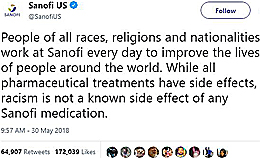


Wide-Awake: Sanofi’s Rapid Response to Roseanne Barr’s Twitter Attack – Lessons Learned
[By Howard Fencl, Hennes Communications]
By now you know the story: Acerbic, sharp-tongued comedian Roseanne Barr shoots her mouth off on Twitter, posting a racist tweet targeting Valerie Jarrett, a former aide to President Barack Obama:
“Muslim brotherhood & planet of the apes had a baby=vj [Valerie Jarrett]”
ABC wastes no time cutting ties with Ms. Barr, canceling the highly successful reboot of “Roseanne” the next day, calling her tweet “…abhorrent, repugnant and inconsistent with our values.”
Ms. Barr wastes no time naming scapegoats, including Sanofi Pharmaceuticals’ prescription insomnia drug, Ambien, inferring the drug’s side effects were behind the tweet:
“It was 2 in the morning and I was ambien tweeting…”
Sanofi, one of the largest pharmaceutical companies in the world, shot back a tweet on the same day Ms. Barr blamed their product for her racist post:
“People of all races, religions and nationalities work at Sanofi every day to improve the lives of people around the world. While all pharmaceutical treatments have side effects, racism is not a known side effect of any Sanofi medication.”
Sanofi’s U.S. division was behind the lightning-quick response. Though the textbook is still being written on real-time reputation management required to squelch attacks on social media, Sanofi’s U.S. communications team reinforced these important points your business should embrace:
- React quickly, no matter how big your organization. Big companies – particularly old ones – can get caught in a tangle of their own red tape. Your communications people must have the courage to cut through layers of bureaucracy to get key messages approved and disseminated before your reputation takes a hit – perhaps a painful financial hit – as a result of baseless social media posts. Whether it’s a Hollywood celeb or the Oval Office assaulting your brand on social platforms, you must be ready to drop everything and defend your reputation at a moment’s notice.
- Respond on the same social media platform. If you’re attacked on Twitter, your first response should be on Twitter. If it’s Facebook, post there first. Once you do, you should then post your key messages, or links to your statement, on all of your other social media platforms and in the “News” section of your web site.
- Correct misstatements. While Ambien can have peculiar side effects on some individuals, Sanofi’s point was clear: the possibility of pharmaceutical side effects does not excuse Ms. Barr’s racist post.
- Respond like a human, and not in corporate-speak. Sanofi did this with droll humor – and perhaps a bit of sarcasm and snark.
Waking up horrified to find your company under attack on social media is a rude awakening, indeed, but if you immediately muster your communications experts and legal team and instruct them to draft and approve a response within an hour, you can minimize damage to your reputation, spread your message among followers and key audiences on your social platforms, and buy enough time to plan your next strategic communications move.
If you’d rather not wake up in a drenching sweat, and want to take steps now to prepare for a social media attack, my colleague, Thom Fladung, offered these additional suggestions in a past blog post you should bookmark:
- Know where your audience lives. Are the people who care most about your organization more likely to be on Facebook, Twitter, Instagram, your own website, all of the above? You can’t get to your key stakeholders during a crisis if you don’t know where they are.
- Secure your accounts. Make sure your social media accounts aren’t subject to being hacked or hijacked.
- Make certain you can access Facebook, Twitter and other social media platforms yourself, at a moment’s notice. Especially if you’ve outsourced that work to third-party marketing or PR firms, if they’ve activated Two-Factor Authentication (a secondary layer of security to make it more difficult for your account to be hacked), you may find yourself unable to access those accounts, even if you have the screen name and password.
- Establish social media guidelines. Do your employees understand expectations about what to say and when to say it on your Facebook pages and Twitter feeds? And what about their personal social media outlets?
- Build a following, promote interaction. If your social media followers trust you before the crisis, it’s a lot more likely they’ll trust you during it.
###